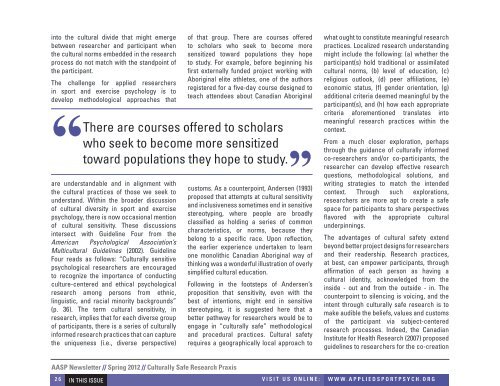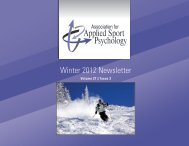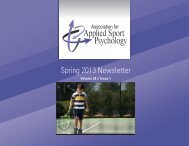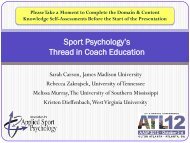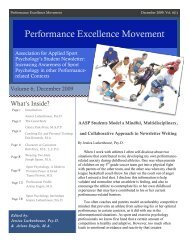Spring 2012 Newsletter - Association for Applied Sport Psychology
Spring 2012 Newsletter - Association for Applied Sport Psychology
Spring 2012 Newsletter - Association for Applied Sport Psychology
Create successful ePaper yourself
Turn your PDF publications into a flip-book with our unique Google optimized e-Paper software.
into the cultural divide that might emerge<br />
between researcher and participant when<br />
the cultural norms embedded in the research<br />
process do not match with the standpoint of<br />
the participant.<br />
The challenge <strong>for</strong> applied researchers<br />
in sport and exercise psychology is to<br />
develop methodological approaches that<br />
are understandable and in alignment with<br />
the cultural practices of those we seek to<br />
understand. Within the broader discussion<br />
of cultural diversity in sport and exercise<br />
psychology, there is now occasional mention<br />
of cultural sensitivity. These discussions<br />
intersect with Guideline Four from the<br />
American Psychological <strong>Association</strong>’s<br />
Multicultural Guidelines (2002). Guideline<br />
Four reads as follows: “Culturally sensitive<br />
psychological researchers are encouraged<br />
to recognize the importance of conducting<br />
culture-centered and ethical psychological<br />
research among persons from ethnic,<br />
linguistic, and racial minority backgrounds”<br />
(p. 36). The term cultural sensitivity, in<br />
research, implies that <strong>for</strong> each diverse group<br />
of participants, there is a series of culturally<br />
in<strong>for</strong>med research practices that can capture<br />
the uniqueness (i.e., diverse perspective)<br />
of that group. There are courses offered<br />
to scholars who seek to become more<br />
sensitized toward populations they hope<br />
to study. For example, be<strong>for</strong>e beginning his<br />
first externally funded project working with<br />
Aboriginal elite athletes, one of the authors<br />
registered <strong>for</strong> a five-day course designed to<br />
teach attendees about Canadian Aboriginal<br />
There are courses offered to scholars<br />
who seek to become more sensitized<br />
toward populations they hope to study.<br />
customs. As a counterpoint, Andersen (1993)<br />
proposed that attempts at cultural sensitivity<br />
and inclusiveness sometimes end in sensitive<br />
stereotyping, where people are broadly<br />
classified as holding a series of common<br />
characteristics, or norms, because they<br />
belong to a specific race. Upon reflection,<br />
the earlier experience undertaken to learn<br />
one monolithic Canadian Aboriginal way of<br />
thinking was a wonderful illustration of overly<br />
simplified cultural education.<br />
Following in the footsteps of Andersen’s<br />
proposition that sensitivity, even with the<br />
best of intentions, might end in sensitive<br />
stereotyping, it is suggested here that a<br />
better pathway <strong>for</strong> researchers would be to<br />
engage in “culturally safe” methodological<br />
and procedural practices. Cultural safety<br />
requires a geographically local approach to<br />
what ought to constitute meaningful research<br />
practices. Localized research understanding<br />
might include the following: (a) whether the<br />
participant(s) hold traditional or assimilated<br />
cultural norms, (b) level of education, (c)<br />
religious outlook, (d) peer affiliations, (e)<br />
economic status, (f) gender orientation, (g)<br />
additional criteria deemed meaningful by the<br />
participant(s), and (h) how each appropriate<br />
criteria a<strong>for</strong>ementioned translates into<br />
meaningful research practices within the<br />
context.<br />
From a much closer exploration, perhaps<br />
through the guidance of culturally in<strong>for</strong>med<br />
co-researchers and/or co-participants, the<br />
researcher can develop effective research<br />
questions, methodological solutions, and<br />
writing strategies to match the intended<br />
context. Through such explorations,<br />
researchers are more apt to create a safe<br />
space <strong>for</strong> participants to share perspectives<br />
flavored with the appropriate cultural<br />
underpinnings.<br />
The advantages of cultural safety extend<br />
beyond better project designs <strong>for</strong> researchers<br />
and their readership. Research practices,<br />
at best, can empower participants, through<br />
affirmation of each person as having a<br />
cultural identity, acknowledged from the<br />
inside - out and from the outside - in. The<br />
counterpoint to silencing is voicing, and the<br />
intent through culturally safe research is to<br />
make audible the beliefs, values and customs<br />
of the participant via subject-centered<br />
research processes. Indeed, the Canadian<br />
Institute <strong>for</strong> Health Research (2007) proposed<br />
guidelines to researchers <strong>for</strong> the co-creation<br />
AASP <strong>Newsletter</strong> // <strong>Spring</strong> <strong>2012</strong> // Culturally Safe Research Praxis<br />
26 In This Issue<br />
Visit us Online:<br />
www.appliedsportpsych.org


